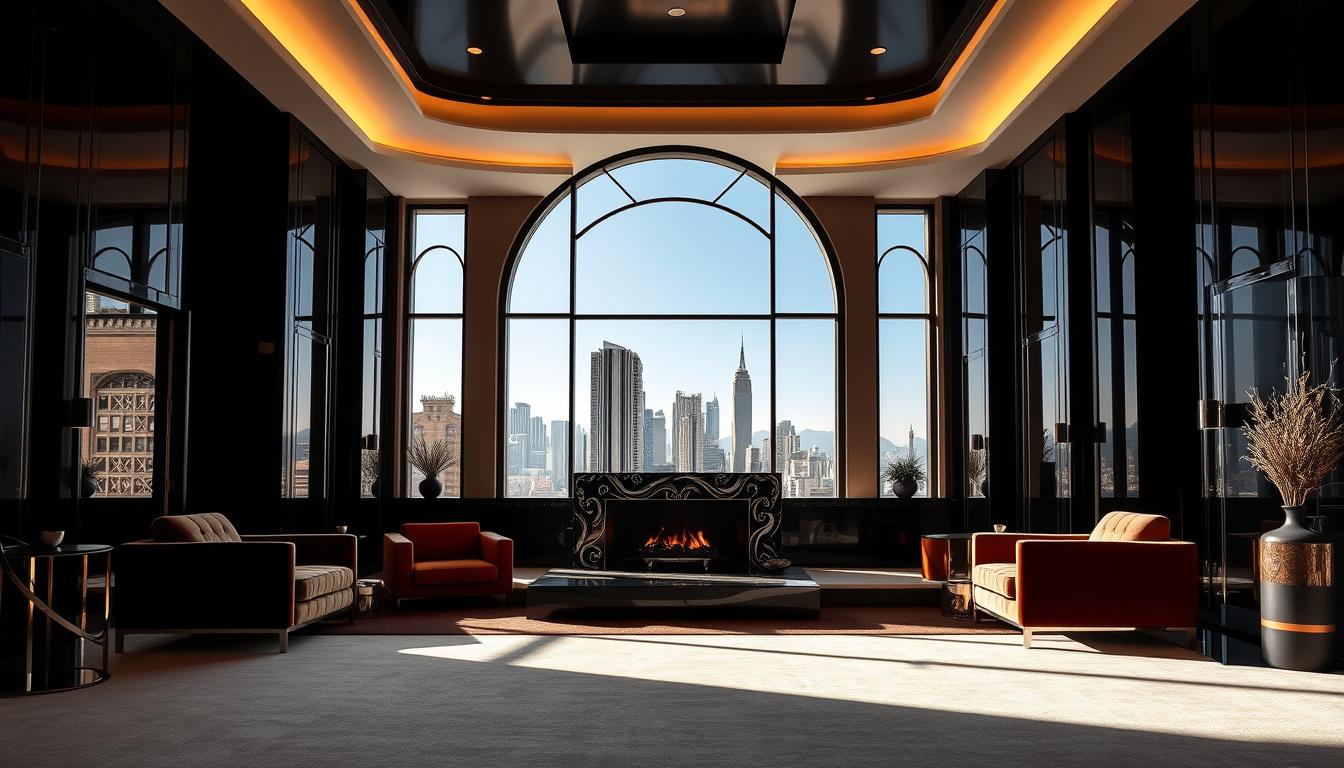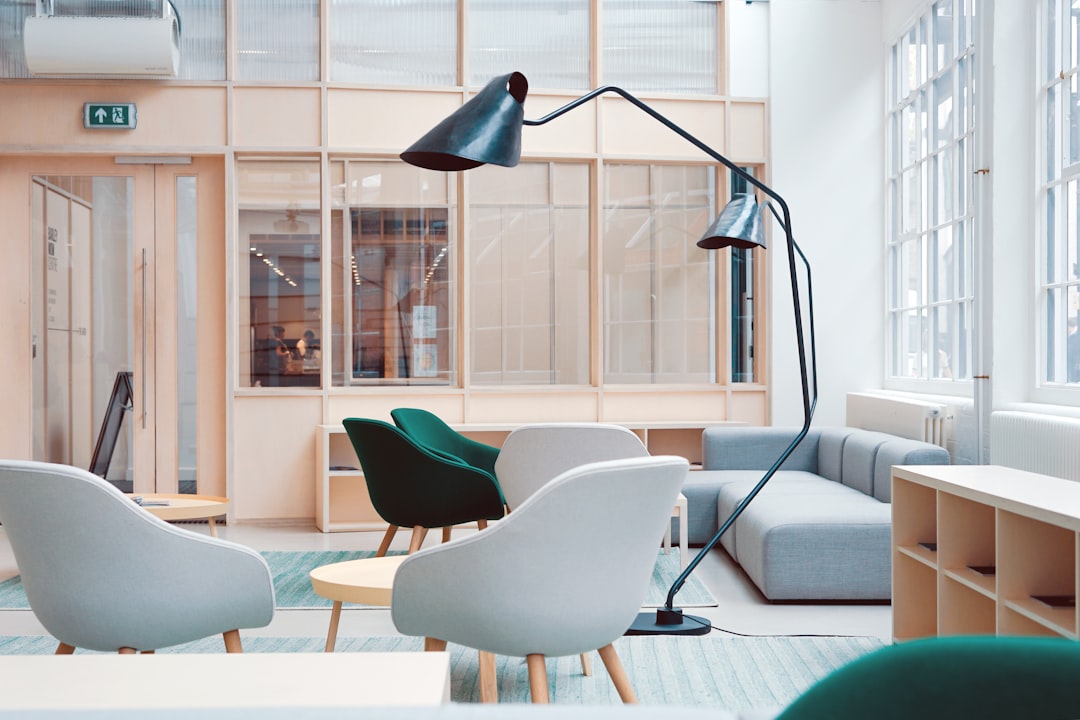Art Deco emerged in the 1920s and is known for its glamorous appeal. It’s a style that adds luxury to homes and public areas. It brings a sense of elegance and sophistication.
We’ll dive into the Art Deco style and its key elements. You’ll learn how to add this luxury to your home. Art Deco is timeless and adds glamour to any space.
Key Takeaways
- Understanding the core elements of Art Deco style
- Tips for incorporating Art Deco into your home decor
- How to balance glamour with functionality
- The significance of Art Deco in modern interior design
- Creating a cohesive Art Deco look
Understanding the Art Deco Movement
The Art Deco movement started in the 1920s. It changed interior design with its bright and modern look. Knowing the history of Art Deco helps us appreciate its interiors more.
The Origins of Art Deco
Art Deco, short for Arts Décoratifs, began in France in the 1920s. It was a response to the strictness of the time. It brought a luxurious and modern look that amazed everyone.
The movement was inspired by many cultures. This includes ancient Egypt and Mesopotamia, and also modern industrial design.
Key Characteristics of Art Deco
Art Deco is known for its geometric patterns, metallic accents, and rich materials. These elements made it feel luxurious and glamorous.
Some common features of Art Deco design include:
- Geometric motifs such as chevrons and zigzags
- Metallic materials like chrome and silver
- Luxurious fabrics such as velvet and silk
- Bold color schemes
Influential Designers and Architects
Many designers and architects helped shape the Art Deco style. Some key figures include:
| Name | Contribution |
|---|---|
| Émile-Jacques Ruhlmann | Furniture design with luxurious materials |
| Jean Dupas | Mural paintings and decorative arts |
| William van Alen | Architect of the Chrysler Building, an iconic Art Deco landmark |
Art Deco is a rich and complex design movement. It still influences interior design today.
Color Palettes for Art Deco Interiors
Art Deco interior design shines with the right color palette. It brings a luxurious and sophisticated vibe. The style is all about making a bold statement, and colors play a big role.
Art Deco is known for its vibrant colors and metallic touches. These colors add to the style’s opulence and glamour. They make the space feel luxurious and eye-catching.
Popular Color Schemes
Art Deco color schemes are bold and eclectic. You’ll see deep blues and greens, rich reds and purples, and metallic silvers and golds. These colors work together to create a stunning visual effect.
- Deep blues and greens bring a sense of luxury and high society.
- Rich reds and purples add opulence and sophistication.
- Metallic silvers and golds bring glamour and modernity.
| Color Scheme | Description | Example Use |
|---|---|---|
| Bold and Bright | Features vibrant colors like red, blue, and green. | Ideal for making a statement in living rooms or dining areas. |
| Metallic Luxe | Incorporates metallic accents like gold, silver, and bronze. | Perfect for adding a touch of glamour to bathrooms or bedrooms. |
| Monochromatic Elegance | Uses different shades of a single color to create a cohesive look. | Effective for creating a sophisticated ambiance in hallways or corridors. |
The Role of Metallics in Art Deco Design
Metallic accents are key in Art Deco design. They add glamour and sophistication. Metals like chrome, silver, and gold create a sense of luxury.
Chrome and silver add a modern, sleek look. Gold brings warmth and high-end luxury.
In conclusion, the color palette is crucial in Art Deco design. Bold colors and metallic accents create an opulent and sophisticated space.
Iconic Patterns and Textures
Art Deco is known for its glamorous look, thanks to geometric motifs and rich materials. These elements make the style feel luxurious and eye-catching.
Geometric Motifs
Geometric patterns are key in Art Deco design. You’ll see chevrons, zigzags, and sunbursts everywhere. They can be used in wallpaper, rugs, furniture, and accessories.
It’s important to mix these bold patterns with simpler designs. This keeps the space from feeling too busy.
When picking geometric patterns, think about their size and colors. For example, a big chevron rug can be balanced by smaller patterns on pillows or vases.
Luxurious Fabrics and Materials
Luxurious fabrics and materials are a big part of Art Deco. Velvet, silk, and satin are favorites for making things feel fancy. Marble, chrome, and ebony are also used to make bold, glamorous pieces.
To add luxury to your space, use these materials for special items. Think throw pillows, ottomans, or a standout wall covering. This creates a stylish, sophisticated look.
Here are some ways to add luxury:
- Velvet drapes can make windows look elegant.
- Marble or granite can be used in furniture or decor.
- Chrome or metallic accents on furniture add glamour.
By adding geometric patterns and luxurious fabrics thoughtfully, you can make a space that looks both authentic and beautiful.
Furniture Selection in Art Deco
Furniture selection is key in creating an authentic Art Deco interior. This style is known for its opulence and glamour. It needs furniture that is both stylish and functional.
When picking furniture for an Art Deco space, iconic designs from the era are crucial. Stylish sofas and chairs were a hallmark, featuring geometric patterns and luxurious fabrics.
Stylish Sofas and Chairs
Art Deco sofas and chairs have sleek lines and luxurious materials. They often have geometric motifs and rich upholstery. For example, a sofa with a metallic sheen or a chair with inlaid wooden patterns adds glamour.
Some popular designs include:
- Sofas with tufted upholstery and chrome accents
- Chairs with curved lines and exotic wood veneers
- Ottomans with geometric patterns and luxurious fabrics
Designer Émile-Jacques Ruhlmann believed furniture making is about creating beautiful works of art. This philosophy is seen in the exquisite designs of the Art Deco era.
“The modern decorator is now able to choose from a vast array of materials, and it is this freedom of choice that has led to the development of a new style, one that is both modern and rich in tradition.”
Statement Tables and Storage
Statement tables and storage units are essential for the Art Deco look. They often have intricate inlays, exotic materials, and geometric shapes.
| Furniture Piece | Characteristics | Materials |
|---|---|---|
| Coffee Tables | Geometric shapes, inlaid patterns | Wood, glass, metal |
| Side Tables | Curved lines, luxurious finishes | Exotic woods, marble |
| Cabinets | Ornate details, metallic accents | Wood, metal, glass |
When choosing tables and storage, look for pieces that reflect the glamour of Art Deco. Consider materials, shapes, and details that complement your design.
Lighting Solutions for an Art Deco Space
The right lighting can turn a room into an Art Deco masterpiece. It adds glamour and sophistication. Lighting fixtures in Art Deco are not just for light; they are decorative pieces that enhance the space’s look.
When picking lighting for an Art Deco room, think about its key elements. These include geometric shapes, metallic materials, and ornate details. We’ll look at lighting options that match these, helping you create a stunning Art Deco space.
Chandeliers and Pendant Lights
Chandeliers and pendant lights are key in Art Deco. They often have geometric shapes, metallic finishes, and detailed designs. These lights become the room’s centerpiece.
Some popular Art Deco lighting includes:
- Crystal chandeliers that refract light and add luxury
- Geometric pendant lights with metallic finishes like chrome or brass
- Sputnik chandeliers with multiple arms and decorative elements
Unique Sconces and Lamps
Sconces and lamps are also vital in Art Deco lighting. They provide ambient light and highlight design elements or architectural features.
Art Deco sconces and lamps often have:
| Feature | Description | Example |
|---|---|---|
| Geometric Shapes | Sconces and lamps often feature geometric shapes like triangles, circles, and zigzags. | A sconce with a triangular motif and metallic finish |
| Metallic Finishes | Metallic materials like chrome, brass, and silver are commonly used. | A lamp with a chrome base and glass shade |
| Ornate Details | Intricate designs and patterns are characteristic of Art Deco lighting. | A sconce with an ornate, filigree-inspired design |
By using these lighting solutions, you can make an Art Deco space glamorous and sophisticated. Whether it’s a statement chandelier or a unique sconce, the right lighting will enhance your interior design.
Incorporating Art Deco Artwork
Adding Art Deco artwork to your home design brings elegance and sophistication. This style, known for its luxury, uses bold artwork to complete its look.
Art Deco art often has geometric shapes, metallics, and vibrant colors. These elements reflect the era’s opulence. To achieve an authentic Art Deco look, choose artwork that matches these traits.
Famous Artists and Their Works
Many famous artists have shaped the Art Deco movement. Tamara de Lempicka’s portraits capture the glamour of the 1920s. Jean Dupas’s murals adorned luxurious buildings, becoming iconic in Art Deco.
Their work showcases the style’s focus on luxury and modernity. It also highlights the fascination with ancient cultures and geometric patterns. Their pieces are often found in high-end Art Deco interiors, adding authenticity and sophistication.
Tips for Selecting Art Deco Art
When picking Art Deco art, look for motifs like chevron patterns and metallic accents. It’s important to choose pieces that fit your color scheme and design.
- Look for artwork with bold, geometric patterns.
- Consider pieces that incorporate metallic materials like silver, gold, or bronze.
- Choose artwork that reflects the era’s love for luxury and opulence.
By carefully choosing Art Deco artwork, you can make your space glamorous and true to the Art Deco spirit.
Flooring Options for Art Deco Design
The right flooring is key for Art Deco interiors. It sets the room’s look and how other elements fit together.
Art Deco loves luxury, and flooring is a big part of that. You can pick from many materials and patterns to make a stunning space.
Hardwood and Parquet Patterns
Hardwood flooring is classic and fits Art Deco well. Hardwood looks luxurious and can be stained in many colors. Parquet patterns, with their geometric designs, add depth and interest.
Parquet was big in Art Deco for its creative patterns. You can pick different woods and stains for a unique look that matches your decor.
Luxurious Rugs and Carpets
Luxurious rugs and carpets are also important in Art Deco design. A rug can add warmth, texture, and color. For an authentic look, choose rugs with bold geometric patterns or motifs inspired by ancient cultures.
Think about the material of your rug or carpet too. Materials like silk or high-quality wool add luxury. Make sure the rug complements the room’s design without overwhelming it.
Choosing the right flooring, like hardwood with parquet or a luxurious rug, can really enhance your Art Deco space. Each choice helps create a cohesive and stylish room.
Architectural Elements of Art Deco
The architectural elements of Art Deco are key to its luxurious style. They use curved lines and symmetry to make interiors stunning. These features not only make a space look good but also add glamour and sophistication.

Curved Lines and Symmetry
Art Deco architecture is known for its curved lines. You can see these in doorways, arches, and furniture. They add elegance and smoothness to a space. Symmetry is also crucial, achieved with identical or mirrored elements on both sides of a central axis. This balance brings order and harmony, typical of Art Deco.
The mix of curved lines and symmetry in Art Deco creates a unique look. For example, a curved staircase with symmetrical banisters can be a room’s centerpiece. It shows luxury and refinement.
Use of Mirrors and Glass
Mirrors and glass are essential in Art Deco architecture. They add depth and opulence. Mirrors make rooms seem larger and brighter. Glass elements, like tables or panels, bring sophistication. Placing these materials wisely can make a space feel more luxurious and welcoming.
Mirrors and glass also play with light in a space. By placing mirrors opposite windows or light sources, designers can increase natural light. This makes rooms feel brighter and more airy.
Accessories to Enhance Art Deco Style
Accessories are key to perfecting the Art Deco look in your home. They complete the look, tying everything together. It’s important to pick accessories that match the style and era you want to achieve.
Choosing Decorative Objects
Decorative objects are essential in Art Deco interiors. Geometric shapes, metallic materials, and bold colors are what define this style. Look for items that show these traits, like a vase with a geometric pattern or a figurine with metallic accents.
Think about how to display your decorative objects. Big pieces can stand out on mantels or side tables. Smaller items look great on a decorative tray or shelf. The goal is to show off your accessories without cluttering the space.
The Importance of Sculpture
Sculpture is also a great way to enhance an Art Deco room. Sculptures with clean lines, abstract forms, and a sense of luxury fit perfectly. They can make a room more interesting or create a focal point.
When picking a sculpture, look at the material and finish. Bronze, marble, and glass are favorites for their luxury and look. The sculpture should match your décor and add something special to the room.
By carefully choosing and displaying decorative objects and sculptures, you can make your Art Deco interior more elegant and eye-catching.
Outdoor Spaces with an Art Deco Touch
Art Deco isn’t just for inside; it can also make outdoor spaces luxurious. By adding the style’s glamour and sophistication, we can make outdoor areas as stylish as indoors.
Designing Art Deco Patios
Creating an Art Deco patio means choosing furniture and decor that show off the style’s luxury. Luxurious materials like marble, chrome, and exotic woods are key. We can use these in our patio furniture and decor for a unified look.
Geometric patterns, a big part of Art Deco, can be added with tiles, rugs, and planters. These patterns make the space interesting and sophisticated. Pick patterns that match the color scheme and overall design.
Landscaping Ideas That Complement the Style
Landscaping is key to an Art Deco outdoor space. The style loves symmetrical designs and geometric shapes. We can use trees, shrubs, and flowers to achieve this. Topiaries and hedges also fit the Art Deco look, giving a formal feel.
We can also add fountains and statues to enhance the Art Deco vibe. These features add beauty and make the space feel luxurious and sophisticated.
By choosing the right landscaping elements and adding them to our design, we can make outdoor spaces that capture Art Deco’s glamour and sophistication.
Staying Authentic with Renovations
Renovating an Art Deco property needs careful thought. We must keep its unique style while adding modern touches. It’s all about finding the right balance.
To get this balance right, we need to know what makes Art Deco special. For more on the style, check out this article on Art Deco interior. It gives a detailed look at the style’s key features.
Preserving Original Features
Keeping the original parts of an Art Deco home is key. This means keeping moldings, door handles, and other details that show off the style.
Some important features to watch for include:
- Geometric patterns and motifs
- Metallic accents like chrome and silver
- Bold, contrasting color schemes
By keeping these elements, we make sure the Art Deco spirit stays alive. Even as we add modern comforts and updates.
Selecting Modern Upgrades that Fit
It’s also vital to add modern touches that make the space better to live in. This could mean updating the electrical, plumbing, and insulation. Or adding new tech and smart home features.
When picking modern upgrades, choose things that match the Art Deco style. For example, sleek finishes or tiles with geometric patterns can keep the style’s look intact.
| Original Feature | Modern Upgrade | Benefit |
|---|---|---|
| Geometric Patterns | Geometric-Patterned Tiles | Maintains aesthetic integrity |
| Metallic Accents | Sleek, Metallic Finishes | Enhances style’s luxurious feel |
| Bold Color Schemes | Modern, Contrasting Colors | Updates the space while retaining its bold character |
By carefully mixing old features with new upgrades, we can make an Art Deco space that’s both true to its roots and modern.
Final Touches: Bringing It All Together
As we wrap up our guide to stunning Art Deco interiors, let’s talk about the final touches. These details are key to making your space look great. It’s all about creating a cohesive look that feels right.
Cohesion in Design
To get a unified look, mix bold geometric patterns with shiny metals and soft fabrics. This mix adds depth and class to your room. For more ideas on Art Deco interiors, check out our guide on Cozy Nest Plans.
Adding a Personal Touch
Make your Art Deco space truly yours by adding personal touches. Use unique decor, standout art, or vintage items that show your style. This way, your space will feel warm and show off your taste.



